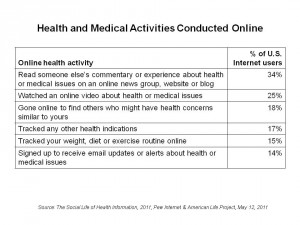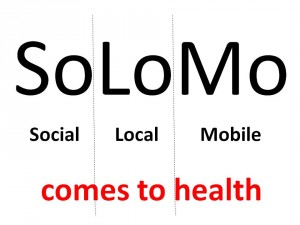 Health professionals are go-to sources for medical diagnoses, information about prescription drugs and alternative treatments, and recommendations for doctors and hospitals. On the other hand, health information seekers turn to fellow patients, friends and family for emotional support in dealing with health issues, and quick remedies for everyday issues.
Health professionals are go-to sources for medical diagnoses, information about prescription drugs and alternative treatments, and recommendations for doctors and hospitals. On the other hand, health information seekers turn to fellow patients, friends and family for emotional support in dealing with health issues, and quick remedies for everyday issues.
And increasingly, those health information searches are going mobile, with 17% of U.S. adults having ever used their cell phone to look up health or medical information. This proportion nearly doubles for 18-29 year olds, and is also higher for wealthier people, Latino’s, college graduates, and urbanites. 1 in 10 people with a cell phone has at least one health app to track or manage health.
The Pew Internet & American Life Project has updated The Social Life of Health Information, now in its 2011 iteration led by the project’s Associate Director, Susannah Fox. This survey has become the health industry’s primary source of insights about Americans’ use of the internet for health information seeking and is co-sponsored by the California HealthCare Foundation (CHCF).
Health information seeking online is mainstream health behavior in the U.S. across ages, gender, and income segments. However, in 2011 there’s still a disparity between lower-income and less-educated health citizens in online health information seeking. Overall, 59% of U.S. adults seeks health information online; only 24% of people with some high school and 41% of people with less than $30,000 household income do so. There’s also a big drop-off for people 65 and over with 29% going online for health information compared with 58% of people 50-64.
There is still a slight disparity in 2011 among people with one or more chronic conditions, 53% of whom seek health information online compared with 62% of “well” people who do so. This differential also occurs among people with one or more disabilities, only 42% of whom seek health information online. The Pew points to these groups’ lack of access to the internet “holding them back” from parity with people who report no chronic conditions or disability.
The survey is based on a poll of 3,011 adults, 18 and over, conducted in August and September 2010. The survey was conducted via telephone (using both landline and cell numbers), in English and Spanish.
 Health Populi’s Hot Points: With health information seeking now part of peoples’ DIY lives like online photo uploading, travel planning, and opinion-sharing, what do the Pew data tell us about that “social life” of health information? Start with SoLoMo – Social, Local and Mobile, which is what the growing use of mobile platforms can bring to personal health. Fox tells us that people prefer different kinds of information from different sources – the “gumbo” that is cooked based on personal preferences for health information types and tools, participatory nodes and channels. Being able to stew that gumbo on-the-go, where we “live, work, play and pray,” enables us to manage when and where we like to. The local aspects help us link into real-time locales where we can consume, purchase, or experience health (and life) where we are at a point in time.
Health Populi’s Hot Points: With health information seeking now part of peoples’ DIY lives like online photo uploading, travel planning, and opinion-sharing, what do the Pew data tell us about that “social life” of health information? Start with SoLoMo – Social, Local and Mobile, which is what the growing use of mobile platforms can bring to personal health. Fox tells us that people prefer different kinds of information from different sources – the “gumbo” that is cooked based on personal preferences for health information types and tools, participatory nodes and channels. Being able to stew that gumbo on-the-go, where we “live, work, play and pray,” enables us to manage when and where we like to. The local aspects help us link into real-time locales where we can consume, purchase, or experience health (and life) where we are at a point in time.
So the health gumbo, then, goes beyond health information: it’s also in the channels and platforms available to us as (dare I say) consumers. We can choose based on our preferences, where our personalization can bolster our health behaviors. Clearly, one size doesn’t fit all in the Web 1.0 world of health information search – as the first chart shows, people seek different kinds of health information at different life-moments. In the Web 2.0 world, where social networking and mobility support more conversations in more places, people can co-create health – connecting with providers, fellow patients, caregivers, loved ones. And find the nearest place to get that flu shot, comment on the clinic’s performance, and track their immunizations.




 Thank you, Jared Johnson, for including me on the list of the
Thank you, Jared Johnson, for including me on the list of the  I am so grateful to Tom Lawry for asking me to pen the foreword for his book, Health Care Nation,
I am so grateful to Tom Lawry for asking me to pen the foreword for his book, Health Care Nation,  Thanks to Feedspot for naming this blog, Health Populi, as a
Thanks to Feedspot for naming this blog, Health Populi, as a